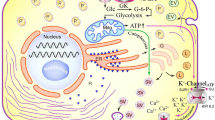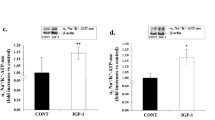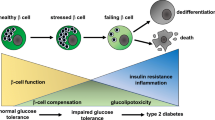Abstract
Insufficient insulin produced by pancreatic β-cells in the control of blood sugar is a central feature of the etiology of diabetes. Reports have shown that endoplasmic reticulum (ER) stress is fundamentally involved in β-cell dysfunction. In this study, we hypothesized that NAD-dependent deacetylase sirtuin-3 (SIRT3), an important regulator of cell metabolism, protects pancreatic β-cells from ER stress-mediated apoptosis. To validate our hypothesis, a rat diabetic model was established by a high-fat diet (HFD). We found that SIRT3 expression was markedly decreased in NIT1 and INS1 cells incubated with palmitate. Palmitate treatment significantly decreased β-cell viability and insulin secretion, and promoted malondialdehyde (MDA) formation. However, SIRT3 overexpression in NIT1 and INS1 cells reversed these effects, resulting in higher insulin secretion, decreased β-cell apoptosis, and downregulation of the expression of ER stress-associated genes. Moreover, SIRT3 overexpression also inhibited calcium influx and the hyperacetylation of glucose-regulated protein of 78 kDa (GRP78). SIRT3 knockdown effectively enhanced the upregulation of phospho-extracellular regulated protein kinases (pERK), inositol-requiring enzyme-1 (IRE1), activating transcription factor 6 (ATF6), and C/EBP homologous protein (CHOP) induced by palmitate, and promoted palmitate-induced β-cell apoptosis and dysfunction. Taken together, our results suggest that SIRT3 is an integral regulator of ER function and that its depletion might result in the hyperacetylation of critical ER proteins that protect against islet lipotoxicity under conditions of nutrient excess.







Similar content being viewed by others
Abbreviations
- SIRT3:
-
Sirtuin-3
- HFD:
-
High-fat diet
- ER:
-
Endoplasmic reticulum
- GRP78:
-
Glucose-regulated protein of 78 kDa
- T1D:
-
Type 1 diabetes
- T2D:
-
Type 2 diabetes
- GD:
-
Gestational diabetes
- UPR:
-
Unfolded protein response
- MDA:
-
Malondialdehyde
- TBA:
-
Thiobarbituric acid
- CHOP, C/EBP:
-
Homologous protein
- GSIS:
-
Glucose-stimulated insulin secretion
- IRE1:
-
Inositol-requiring enzyme-1
- ATF6:
-
Activating transcription factor 6
References
Hasnain SZ, Prins JB, McGuckin MA (2016) Oxidative and endoplasmic reticulum stress in beta-cell dysfunction in diabetes. J Mol Endocrinol 56:R33–R54
Wu L, Zhou L, Lu Y, Zhang J, Jian F, Liu Y, Li F, Li W, Wang X, Li G (2012) Activation of SIRT1 protects pancreatic beta-cells against palmitate-induced dysfunction. Biochim Biophys Acta 1822:1815–1825
Yu C, Cui S, Zong C, Gao W, Xu T, Gao P, Chen J, Qin D, Guan Q, Liu Y, Fu Y, Li X, Wang X (2015) The orphan nuclear receptor NR4A1 protects pancreatic beta-cells from endoplasmic reticulum (ER) stress-mediated apoptosis. J Biol Chem 290:20687–20699
Pluquet O, Pourtier A, Abbadie C (2015) The unfolded protein response and cellular senescence. A review in the theme: cellular mechanisms of endoplasmic reticulum stress signaling in health and disease. Am J Physiol Cell Physiol 308:C415–C425
Walter P, Ron D (2011) The unfolded protein response: from stress pathway to homeostatic regulation. Science 334:1081–1086
Engin F, Yermalovich A, Nguyen T, Hummasti S, Fu W, Eizirik DL, Mathis D and Hotamisligil GS (2013) Restoration of the unfolded protein response in pancreatic beta cells protects mice against type 1 diabetes. Sci Transl Med 5:211ra156
Hirschey MD, Shimazu T, Huang JY, Schwer B, Verdin E (2011) SIRT3 regulates mitochondrial protein acetylation and intermediary metabolism. Cold Spring Harb Symp Quant Biol 76:267–277
Padmaja Divya S, Pratheeshkumar P, Son YO, Vinod Roy R, Andrew Hitron J, Kim D, Dai J, Wang L, Asha P, Huang B, Xu M, Luo J, Zhang Z (2015) Arsenic induces insulin resistance in mouse adipocytes and myotubes via oxidative stress-regulated mitochondrial Sirt3-FOXO3a signaling pathway. Toxicol Sci 146:290–300
Giralt A, Villarroya F (2012) SIRT3, a pivotal actor in mitochondrial functions: metabolism, cell death and aging. Biochem J 444:1–10
Caton PW, Richardson SJ, Kieswich J, Bugliani M, Holland ML, Marchetti P, Morgan NG, Yaqoob MM, Holness MJ, Sugden MC (2013) Sirtuin 3 regulates mouse pancreatic beta cell function and is suppressed in pancreatic islets isolated from human type 2 diabetic patients. Diabetologia 56:1068–1077
Kendrick AA, Choudhury M, Rahman SM, McCurdy CE, Friederich M, Van Hove JL, Watson PA, Birdsey N, Bao J, Gius D, Sack MN, Jing E, Kahn CR, Friedman JE, Jonscher KR (2011) Fatty liver is associated with reduced SIRT3 activity and mitochondrial protein hyperacetylation. Biochem J 433:505–514
Zhou Y, Sun P, Wang T, Chen K, Zhu W, Wang H (2015) Inhibition of calcium influx reduces dysfunction and apoptosis in lipotoxic pancreatic beta-cells via regulation of endoplasmic reticulum stress. PLoS ONE 10:e0132411
Cacicedo JM, Benjachareowong S, Chou E, Ruderman NB, Ido Y (2005) Palmitate-induced apoptosis in cultured bovine retinal pericytes: roles of NAD(P)H oxidase, oxidant stress, and ceramide. Diabetes 54:1838–1845
Chen YY, Sun LQ, Wang BA, Zou XM, Mu YM, Lu JM (2013) Palmitate induces autophagy in pancreatic beta-cells via endoplasmic reticulum stress and its downstream JNK pathway. Int J Mol Med 32:1401–1406
Luo B, Lee AS (2013) The critical roles of endoplasmic reticulum chaperones and unfolded protein response in tumorigenesis and anticancer therapies. Oncogene 32:805–818
Keane KN, Cruzat VF, Carlessi R, de Bittencourt PI Jr, Newsholme P (2015) Molecular events linking oxidative stress and inflammation to insulin resistance and beta-cell dysfunction. Oxid Med Cell Longev 2015:181643
Oyadomari S, Araki E, Mori M (2002) Endoplasmic reticulum stress-mediated apoptosis in pancreatic beta-cells. Apoptosis 7:335–345
Green MF, Hirschey MD (2013) SIRT3 weighs heavily in the metabolic balance: a new role for SIRT3 in metabolic syndrome. J Gerontol A Biol Sci Med Sci 68:105–107
Kim M, Lee JS, Oh JE, Nan J, Lee H, Jung HS, Chung SS, Park KS (2015) SIRT3 overexpression attenuates palmitate-induced pancreatic beta-cell dysfunction. PLoS ONE 10:e0124744
Song Y, Shi J, Wu Y, Han C, Zou J, Shi Y, Liu Z (2014) Metformin ameliorates insulin resistance in L6 rat skeletal muscle cells through upregulation of SIRT3. Chin Med J (Engl) 127:1523–1529
Hirschey MD, Shimazu T, Jing E, Grueter CA, Collins AM, Aouizerat B, Stancakova A, Goetzman E, Lam MM, Schwer B, Stevens RD, Muehlbauer MJ, Kakar S, Bass NM, Kuusisto J, Laakso M, Alt FW, Newgard CB, Farese RV Jr, Kahn CR, Verdin E (2011) SIRT3 deficiency and mitochondrial protein hyperacetylation accelerate the development of the metabolic syndrome. Mol Cell 44:177–190
McDonnell E, Peterson BS, Bomze HM, Hirschey MD (2015) SIRT3 regulates progression and development of diseases of aging. Trends Endocrinol Metab 26:486–492
Oslowski CM, Hara T, O’Sullivan-Murphy B, Kanekura K, Lu S, Hara M, Ishigaki S, Zhu LJ, Hayashi E, Hui ST, Greiner D, Kaufman RJ, Bortell R, Urano F (2012) Thioredoxin-interacting protein mediates ER stress-induced beta cell death through initiation of the inflammasome. Cell Metab 16:265–273
Krokowski D, Han J, Saikia M, Majumder M, Yuan CL, Guan BJ, Bevilacqua E, Bussolati O, Broer S, Arvan P, Tchorzewski M, Snider MD, Puchowicz M, Croniger CM, Kimball SR, Pan T, Koromilas AE, Kaufman RJ, Hatzoglou M (2013) A self-defeating anabolic program leads to beta-cell apoptosis in endoplasmic reticulum stress-induced diabetes via regulation of amino acid flux. J Biol Chem 288:17202–17213
Acknowledgments
This work was supported by National Natural Science Foundation of China (81300656). This work was also supported by National Natural Science Foundation of China grant (81300685).
Author information
Authors and Affiliations
Corresponding author
Ethics declarations
Conflict of interest
The authors declare that they have no conflict of interests.
Rights and permissions
About this article
Cite this article
Zhang, HH., Ma, XJ., Wu, LN. et al. Sirtuin-3 (SIRT3) protects pancreatic β-cells from endoplasmic reticulum (ER) stress-induced apoptosis and dysfunction. Mol Cell Biochem 420, 95–106 (2016). https://doi.org/10.1007/s11010-016-2771-5
Received:
Accepted:
Published:
Issue Date:
DOI: https://doi.org/10.1007/s11010-016-2771-5




